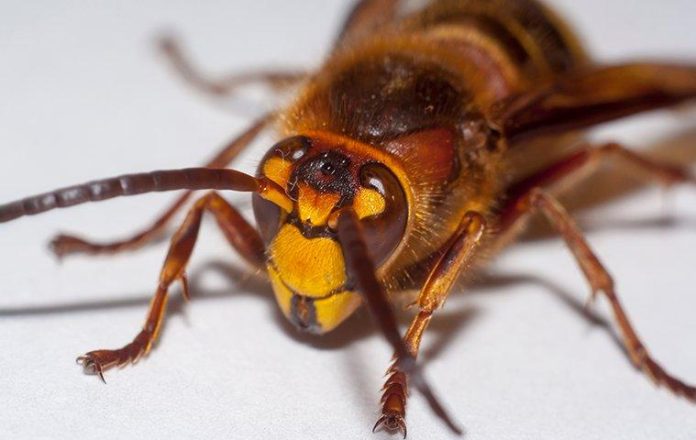Nashville is a community in Tennessee where many people live but are not working in the area. It is a suburban city in the state considered one of the best places to live in. However, your peaceful life can be disturbed by pests like wasps. Wasps can live anywhere and can be annoying because they can sting you. They will live in groups or alone, depending on their species. Today, we will talk about different types of wasps in Nashville, Tennessee, and how you can live a stress-free life with the help of pest control in Nashville.
Table of Contents
Bald-Faced Hornet
Bald-Faced Hornets are not real hornets but rather a type of wasps. They are called hornets because of their enormous size and aggressive nature. You can identify them with their large black color, white face, and slanted lines from their midsection towards their head and the end part of their abdomen. When stung by a bald-faced hornet, you may experience life-threatening allergic reactions because of the presence of venom. That’s why their sting can be extremely painful.
Cicada-Killer Wasp
Cicada-Killer Wasps are another large species of wasps in the United States. They are about 1.5 inches in length. They are called “cicada-killer” or “murder hornets” because they are cicada killers, meaning they spend most of their time preying on cicadas, stinging them, and eating them. That’s why cicada-killer wasps are beneficial, as they can reduce the number of cicadas in your area. Additionally, they are not as aggressive as other species of wasps. Male cicada-killer wasps do not have stingers; female ones sting only when handled. Cicada-killer wasps usually appear during July and remain for the rest of the summer. You can identify them by their black, dark brown, and colorful markings.
Cricket-Hunter Wasp
Cricket-Hunter Wasps are another species of wasps that prey on other pests – crickets. However, they do not kill their prey immediately, unlike cicada-killer wasps. Instead, cricket-hunter wasps only hunt crickets and sting them, rendering them paralyzed. Then, they bring the crickets back to their nest to feed their larva. That is the only time crickets are being killed. The female cricket-hunter wasps will lay eggs on them, and once the eggs are hatched, they will eat the crickets immediately.
A single cricket is good enough for its larva to grow. They spend most of their lives hunting crickets and are not aggressive to humans. Just like cicada-killer wasps, they will only sting you when you handle them. Before, cricket-hunter wasps were unusual but are now common in Texas. You will often see them outdoors during late summer and fall, preying on crickets. They are about ½ to ⅝ inches long and are characterized by their dull black color with gray and dusky-colored wings.
Mud Dauber Wasp
Mud Dauber Wasps are solitary pests, wherein only one wasp lives in a nest and does all the tasks. Mud Daubers are about ¾ to 1 inch in length and vary in color. You can see them in black, black with yellow markings, or shimmery blue and black color. They have a long, narrow waist called a petiole that connects their thorax to their abdomen. They are called “mud” daubers because they create their nest with mud found in moist areas.
Paper Wasp
Paper Wasps do not have yellow markings, unlike other species of wasps. They are another beneficial type of wasps, especially in your garden, because they hunt caterpillars and feed them on their larvae. But adult paper wasps only eat nectar. However, they might be fun to be around because they can cause a painful sting if their nest is disturbed.
Once stung by paper wasps, you may experience an allergic reaction. They are called “paper” wasps because their nests look like paper when dried out. They create their nest with their saliva and wood fragments. Paper wasps often live in urban areas, forests, woodlands, and heath. You may identify them by their small heads, medium-sized eyes, medium-length antennae, slender bodies, narrow waists, and two pairs of brown-tinted wings.
Yellowjacket
Yellowjackets look like bees and are about the size of bees. Like bees, they also have black and yellow bands. And like paper wasps, they also build paper-like nests underground. As a result, they are called “sweaty bees,” but they are not bees. But unlike bees, they are not hairy and do not eat pollen. And unlike paper wasps, their nest has multiple parallel layers of comb with downward-facing cells and is always enclosed in a wood-pulp paper envelope.
Get rid of these wasps now!
Call a pest exterminator immediately if you see any of these types of wasps. They would inspect your home and determine the severity of the wasp infestation to know the proper method to eliminate pests in your area. They would also get to the bottom of the wasp infestation by performing a wasp nest removal to remove the wasps in your area completely and prevent them from returning in the future.
External Links:
https://txbeeinspection.tamu.edu/cicada-killers/
https://txbeeinspection.tamu.edu/mud-daubers/
Client Links:
https://thrivepestcontrol.com/
https://pestcontrolphoenix.pro/
https://saltlakepestcontrol.com/wasp-control/
















